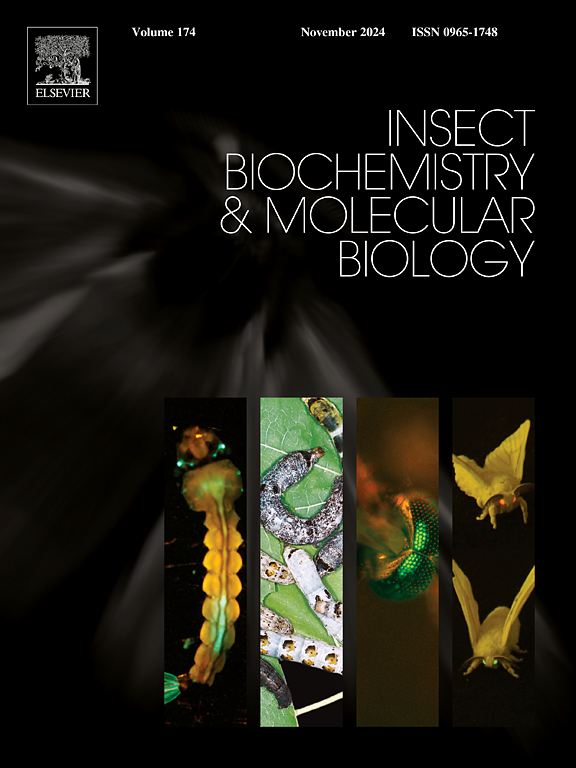Evolution of circadian clock and light-input pathway genes in Hemiptera
IF 3.7
2区 农林科学
Q2 BIOCHEMISTRY & MOLECULAR BIOLOGY
引用次数: 0
Abstract
Circadian clocks are timekeeping mechanisms that help organisms anticipate periodic alterations of day and night. These clocks are widespread, and in the case of animals, they rely on genetically related components. At the molecular level, the animal circadian clock consists of several interconnected transcription-translation feedback loops. Although the clock setup is generally conserved, some important differences exist even among various insect groups. Therefore, we decided to identify in silico all major clock components and closely related genes in Hemiptera. Our analyses indicate several lineage-specific alterations of the clock setup in Hemiptera, derived from gene losses observed in the complete gene set identified in the outgroup, Thysanoptera, which thus presents the insect lineage with a complete clock setup. Nilaparvata and Fulgoroidea, in general, lost the (6–4)-photolyase, while all Hemiptera lost FBXL3, and several lineage-specific losses of dCRY and jetlag were identified. Importantly, we identified non-canonical splicing variants of period and m-cry genes, which might provide another regulatory mechanism for clock functioning. Lastly, we performed a detailed reconstruction of Hemiptera's light input pathway genetic repertoire and explored the horizontal gene transfer of cryptochrome-DASH from plant to Bemisia. Altogether, this inventory reveals important trends in clock gene evolution and provides a reference for clock research in Hemiptera, including several lineages of important pest species.

半翅目生物生物钟和光输入通路基因的进化。
生物钟是一种计时机制,帮助生物体预测昼夜的周期性变化。这些生物钟分布广泛,就动物而言,它们依赖于与基因相关的成分。在分子水平上,动物生物钟由几个相互连接的转录-翻译反馈回路组成。虽然时钟设置通常是保守的,但即使在不同的昆虫群体中也存在一些重要的差异。因此,我们决定在计算机上鉴定半翅目昆虫的所有主要时钟成分和密切相关的基因。我们的分析表明,半翅目昆虫的时钟设置发生了一些谱系特异性的改变,这是由于在外群中发现的完整基因集中观察到的基因丢失,从而使昆虫谱系具有完整的时钟设置。一般来说,Nilaparvata和Fulgoroidea失去了(6-4)-光解酶,而所有半翅目都失去了FBXL3,并且发现了一些谱系特异性的dCRY和时差损失。重要的是,我们发现了周期和m-cry基因的非规范剪接变体,这可能为时钟功能提供另一种调节机制。最后,我们对半翅目昆虫的光输入途径遗传库进行了详细的重建,并探讨了隐色素- dash基因从植物向半翅目昆虫的水平转移。总而言之,该清单揭示了时钟基因进化的重要趋势,并为半翅目昆虫的时钟研究提供了参考,包括一些重要害虫物种的谱系。
本文章由计算机程序翻译,如有差异,请以英文原文为准。
求助全文
约1分钟内获得全文
求助全文
来源期刊
CiteScore
7.40
自引率
5.30%
发文量
105
审稿时长
40 days
期刊介绍:
This international journal publishes original contributions and mini-reviews in the fields of insect biochemistry and insect molecular biology. Main areas of interest are neurochemistry, hormone and pheromone biochemistry, enzymes and metabolism, hormone action and gene regulation, gene characterization and structure, pharmacology, immunology and cell and tissue culture. Papers on the biochemistry and molecular biology of other groups of arthropods are published if of general interest to the readership. Technique papers will be considered for publication if they significantly advance the field of insect biochemistry and molecular biology in the opinion of the Editors and Editorial Board.

 求助内容:
求助内容: 应助结果提醒方式:
应助结果提醒方式:


